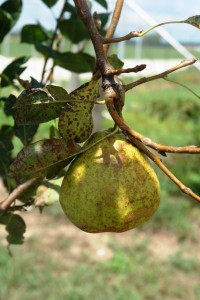We always look forward to the end of August and September for the maturity of one of my favorite fruit, and really one of the easiest to grow sustainably, pears. Across Texas, and indeed all of the south, the variety of pears we can grow is limited by fire blight, a bacterial pathogen that will flat out kill susceptible varieties like ‘Bartlett’. In the highest rainfall, most hot and humid part of the state, standards like ‘Kieffer’ and ‘Orient’ are the most durable and long-lived choices, but in the Hill Country, drier parts of Central Texas and West Texas, we have many other varieties we can grow successfully. . At our sustainable fruit planting in Fredericksburg, we have 14 pear varieties planted, both Asian and European Hybrid types, and we like what we see. There are problems and setbacks however. This week during the first week of May, we had golf ball sized hail for about twenty minutes that hammered our vineyard and everything in the orchard. Most fruit were lost and almost all were at least damaged. A few escaped however and here are a couple of samples of what we have ripening.
The first is the old blight resistant standby ‘Orient’. Not a favorite fresh eating pear, its great for canning or cooking. Very blight resistant and productive, this pear is a good choice for growers in East Texas or the Gulf Coast.
The next and one of my favorites is ‘Ayres’, a 1954 release from the Tennessee Ag. Experiment Station that arose as the result of a cross between ‘Garber’ and ‘Anjou’. ‘Ayres’ can be a bit small, but its attractive blush, sweet, aromatic flavor and melting flesh make it one of the best pears we can grow. ‘Ayres’ is pollen sterile, so it must be planted with other varieties to set fruit. It has held up to fire blight pressure very well across the Hill Country.
This next pear came to us from my neighbor across the creek, Lewis Hussing. His pear tree is easily forty years old and when he gave me fruit a few years ago, I flipped. Easily the best pear I have ever had. Sending photos around, George Ray McEachern identified this pear variety as ‘LeConte’. That’s what we think it is, and fruit from our Fredericksburg orchard this past year did not disappoint us. Amazing that from the old heirloom varieties we already have that there are pears we can grow that are this good!



